Timna
As we drive in from the main highway, we see, ahead on the left, the dark brown Mount Timna, which is mostly granite. If we have an extra couple of hours, we can leave the bus at the ticket gate and follow a geological trail up the mountain. (The bus can wait by Solomon's Pillars.) At the top we can get a view over the Timna valley, which bends in a semi-circle from north to west to south.
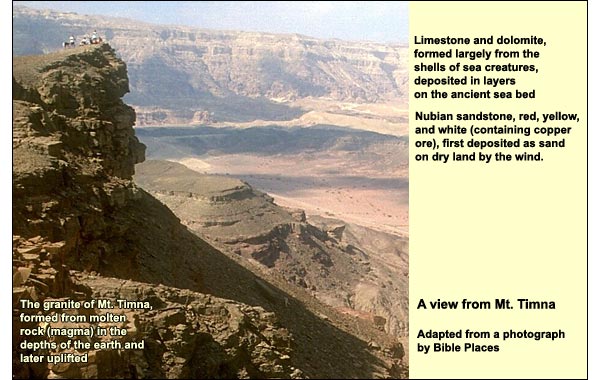
,
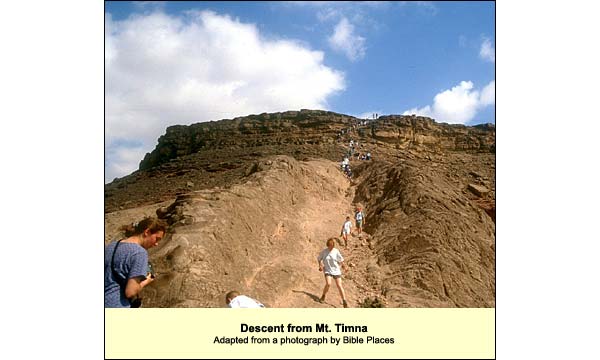
{mospagebreak title=Solomon's Pillars} Solomon's Pillars
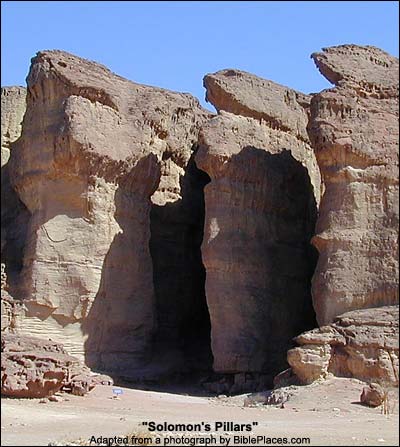
If we circle Mt. Timna with the bus, rather than hiking up and down it, we make our first stop on the southwest side of the mountain at "Solomon's Pillars." GlueckNelson Glueck, The Other Side of the Jordan, New Haven, Connecticut: American Schools of Oriental Research, 1940 (p. 77) dated most of the pottery shards here, as well as those in other copper-mining sites near the Arava, to the time of Solomon and after. The Biblical account of Solomon's wealth, including his seafaring expeditions from Ezion-Geber in quest of gold, led Glueck to entitle a chapter "King Solomon's Copper Mines." From this the pillars get their name. Today, however, archaeologists attribute most of Timna's pottery to the Egyptians of the 12th century BC. There are also earlier shards from the ChalcolithicThe Chalcolithic (Copper-Stone) Age lasted from about 4000 until about 3100 BC. For the first time people were able to extract metal from ore. They managed to achieve temperatures of 1200 degrees centigrade in smelting ovens, which resulted in the separation of copper. Chalcolithic finds are numerous in this land – moreso than anywhere else in the world. (Copper-stone) Era, and later examples from the Midianites. No trace of Solomon. The pillars are made of sandstone, that is, of quartz nuggets bound by natural cement, containing iron, manganese and copper. The cement is vulnerable to erosion. It is conceivable that during the formation of the Dead Sea TransformThis rip in the earth's crust belongs to the divergence of the Asian and African tectonic plates. The Transform extends about 600 miles from the southern edge of Turkey to the Red Sea, reaching its deepest point – indeed, the deepest point on the face of the earth – at the Dead Sea (about 400 meters below world sea level). the mountain developed cracks. Water got into the cracks and sculpted these forms. The effect is impressive, especially when we lie near the base of the pillars and look up. The ancient Egyptians too were impressed. On the nearby hill just west of us, they apparently conducted religious rites. The north end of that hill, slightly higher than the rest, forms a natural altar in the direction of the pillars. Near this altar are human-made cup-like depressions, probably for receiving libations. {mospagebreak title=Midianite Tent Shrine} The Temple to Hathor, later a Midianite Tent Shrine Around the corner south of the pillars, moreover, are the ruins of a temple. Within this little space (9 by 7 meters), archaeologists made hundreds of finds. Dominant were fragments from figurines of the Egyptian goddess Hathor, as well as jewelry associated with her (thousands of pearls, for instance) . In front of the Holy of Holies, which probably contained her statue, were two rectangular basins. These held pillars whose capitals had her image, later partly effaced. Who was Hathor and what was she doing in a place like this?
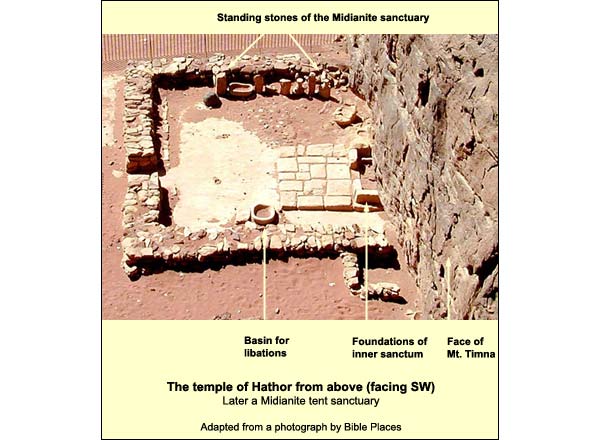
Her name means "the house of Horus" (an Egyptian god associated with the sky, the sun and the moon). She gave birth to him qua sun each morning. She was often pictured as a cow, or as having cow's ears. The Egyptians beheld the Milky Way embracing the night sky, and they thought it a river of milk flowing from cow teats. The god of the sky was Horus the falcon, his eyes composed of the sun and the moon, watching humankind as he flew across the heavens. So the Milky Way (Hathor) was seen as embracing Horus (the night sky), in the manner of mother and child. Hathor's connection with Timna derives from her fecundity. She presided over the instruments of arousal and seduction, such as music, dance, jewelry and cosmetics. The quest for jewelry led the Egyptians to the turquoise of central Sinai. Hathor was worshiped, therefore, at the turquoise mines. Timna has only copper, but having established herself over one kind of mine, Hathor's hegemony spread to the others too.
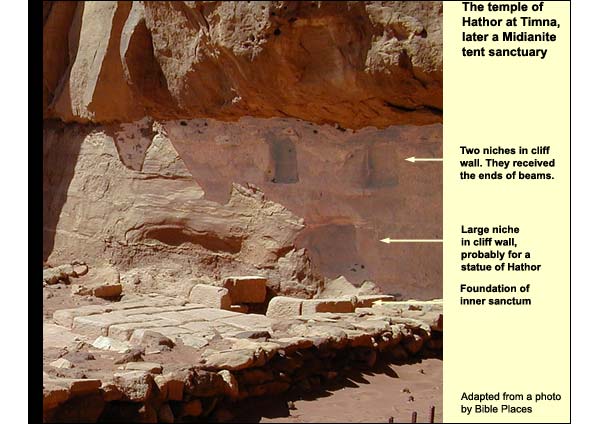
A staircase leads up from the temple to a rock ledge where one can see an engraving in the cliff face, unnoticed until 1972. The inscription tells us what is represented: Pharaoh Rameses III (who ruled from 1184 until 1153 BC) brings an offering to Hathor. In the Harris Papyrus, the following boast is placed in the mouth of Rameses III (since the journey from Timna to Egypt is equally arduous by land and sea, archaeologist Beno RothenbergBeno Rothenberg, Timna: Tal des biblischen Kupfers, Bochum, 1973. English version: Timna - Valley of the Biblical Copper Mines [New Aspects of Antiquity, ed. Mortimer Wheeler] Thames & Hudson: London, 1972 (p. 201) suggested that "Atika" in this text may have been Timna): I sent forth my messenger to the country of Atika, to the great copper (hmt) mines which are in this place. Their galleys carried them; others on their land-journey were upon their asses. It has not been heard before, since kings reign. Their mines were found abounding in copper; it was loaded by 10,000's into their galleys. They were sent forward to Egypt, and arrived safely. It was carried and made into a heap under the balcony, in many bars of copper, like hundred-thousands, being the color of gold of three times. I allowed all the people to see them, like wonders.
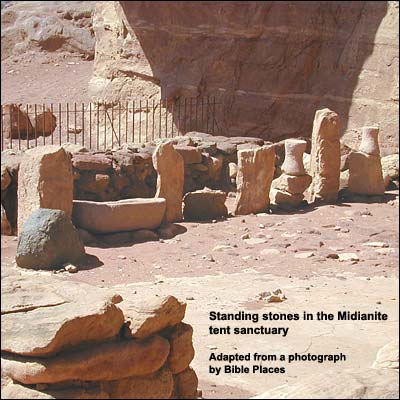
In the last half of the 12th century BC, the temple changed hands. The Egyptians, under pressure of a great upheaval throughout the easten Mediterranean, withdrew from all of Canaan and Timna as well. The pottery attests that Midianites took over. Indigenous to the region, they had probably been laborers under the Egyptians. To them the archaeologists attribute a large quantity of linen and wool, dyed red and yellow and interwoven with pearls, found just inside the east and west walls of the structure. So much cloth led to the conclusion that the Midianites had turned the temple into a tent sanctuary. They had also broken the images of Hathor, setting up instead a series of standing stones (matzevot) along the western wall. To the Midianites the archaeologists also attributed a copper snake with a gilded head, not quite five inches long, the sole find from the Holy of Holies. This tent sanctuary brings to mind the Israelites, whose Tent of Meeting.Exodus 33: 7-11. Now Moses used to take the tent and to pitch it outside the camp, far away from the camp, and he called it “The Tent of Meeting.” It happened that everyone who sought Yahweh went out to the Tent of Meeting, which was outside the camp. It happened that when Moses went out to the Tent, that all the people rose up, and stood, everyone at their tent door, and watched Moses, until he had gone into the Tent. It happened, when Moses entered into the Tent, that the pillar of cloud descended, stood at the door of the Tent, and spoke with Moses. All the people saw the pillar of cloud stand at the door of the Tent, and all the people rose up and worshiped, everyone at their tent door. Yahweh spoke to Moses face to face, as a man speaks to his friend. He turned again into the camp, but his servant Joshua, the son of Nun, a young man, didn’t depart out of the Tent. appears frequently in the latter part of Exodus. The Bible shows, early on, a close connection between Israel and Midian. After slaying an Egyptian, Moses fled to Midian.Exodus 2: 15-21. Now when Pharaoh heard this thing, he sought to kill Moses. But Moses fled from the face of Pharaoh, and lived in the land of Midian, and he sat down by a well. Now the priest of Midian had seven daughters. They came and drew water, and filled the troughs to water their father’s flock. The shepherds came and drove them away; but Moses stood up and helped them, and watered their flock. When they came to Reuel, their father, he said, “How is it that you have returned so early today?” They said, “An Egyptian delivered us out of the hand of the shepherds, and moreover he drew water for us, and watered the flock.” He said to his daughters, “Where is he? Why is it that you have left the man? Call him, that he may eat bread.” Moses was content to dwell with the man. He gave Moses Zipporah, his daughter. Here he married Zipporah, daughter of a Midianite priest (to whom the Bible gives two names: Jethro and Reuel). In Midian, while tending Jethro's flocks, he first encounters Yahweh at the burning bush.Exodus 3: 1-2. Now Moses was keeping the flock of Jethro, his father-in-law, the priest of Midian, and he led the flock to the back of the wilderness, and came to God’s mountain, to Horeb. The angel of Yahweh appeared to him in a flame of fire out of the midst of a bush. He looked, and behold, the bush burned with fire, and the bush was not consumed. Yahweh's original home may have been Midian. An Egyptian source (14th century BC) mentions a "land of Yahweh" where nomads live, and this may have been Midian.Or Syria. See M. Astour, "Yahweh in Egyptian Topographical Lists," Festschrift Elmar Edel [ed. M. Gorg and E. Push], pp. 17-33. In the Song of Deborah, when Yahweh marches forth as a miraculous storm to bog down the Canaanite chariots, He comes from the land of Edom or "Se'ir," the southern part of which had earlier been Midian. The connection does not stop there. Jethro provides Moses with an administrative system for judging disputes. Later Moses asks Hobab,Numbers 10: 29-34. Moses said to Hobab, the son of Reuel the Midianite, Moses’ father-in-law, “We are journeying to the place of which Yahweh said, ‘I will give it to you.’ Come with us, and we will treat you well; for Yahweh has spoken good concerning Israel.” He said to him, “I will not go; but I will depart to my own land, and to my relatives.” He said, “Don’t leave us, please; because you know how we are to encamp in the wilderness, and you can be our eyes. It shall be, if you go with us, yes, it shall be, that whatever good Yahweh does to us, we will do the same to you.” They set forward from the Mount of Yahweh three days’ journey. The ark of the covenant of Yahweh went before them three days’ journey, to seek out a resting place for them. The cloud of Yahweh was over them by day, when they set forward from the camp. his Midianite brother-in-law, to guide the people through the wilderness. We may even see a connection to the copper snake with gilded head, found in the Midianite Holy of Holies. Moses, we recall, made a bronze serpentNumbers 21: 6-9. Yahweh sent fiery serpents among the people, and they bit the people; and many people of Israel died. The people came to Moses, and said, “We have sinned, because we have spoken against Yahweh, and against you. Pray to Yahweh, that he take away the serpents from us.” Moses prayed for the people. Yahweh said to Moses, “Make a fiery serpent, and set it on a standard: and it shall happen, that everyone who is bitten, when he sees it, shall live.” Moses made a serpent of brass, and set it on the standard: and it happened, that if a serpent had bitten any man, when he looked to the serpent of brass, he lived. which was worshiped at the Temple in Jerusalem until King Hezekiah tore it down.2 Kings 18:4. He removed the high places, and broke the pillars, and cut down the Asherah: and he broke in pieces the bronze serpent that Moses had made; for in those days the children of Israel burned incense to it; and he called it Nehushtan. {mospagebreak title=Copper at Timna} Copper at Timna and the Mushroom Camp
Copper was the first metal human beings ever had. It lent its name to the period when they learned to extract it from ore: the Chalcolithic era, that is, the copper-stone age, which extended from 4000 to 3100 BC. After that people learned to mix copper with tin to get bronze.
At the time when people first extracted metal, farming had been going on already for 4000 years,Agriculture did not begin in the luxuriant valleys of Egypt and Mesopotamia, where there would have been "too much competition from the natural vegetation. It originated in the wooded rocky hills where competition was less intense and where the ancestors of modern crops were already growing in the open spaces between the trees. (See F. Nigel Hepper, Illustrated Encyclopedia of Biblical Plants, Leicester, England: Intervarsity Press, 1992, p. 76.) The first evidence of farming appears, as far as we know, ca. 8000 BC at a place called Catal Hüyük, high up on what is today the Turkish plateau. duriing which the basic tool was the digging stick. It served as spade, hoe and rake.
The introduction of the metal hoe had a major effect. Such a hoe turns up the soil to a much greater depth than the stick does. This was of great importance in societies that did not employ fertilizers and hence quickly depleted the nutrients in the surface soil (Lenski,Gerhard E. Lenski, Power and Privilege, Chapel Hill: University of North Carolina, 1984 p. 144). After they had bronze hoes, farmers could remain for a longer time in one place, cultivate wider areas, and get greater yields from each plot. For the first time people produced enough of an economic surplus to sustain the kind of military and political machines required for empire-building. According to anthropologists, digging-stick societies seldom amounted to more than 15,000 people; hoe-wielding societies (the Inca and the Maya, for instance) numbered in the millions. The next step would be the iron plow (ca. 1400 BC), which would help bring about another leap in social development.
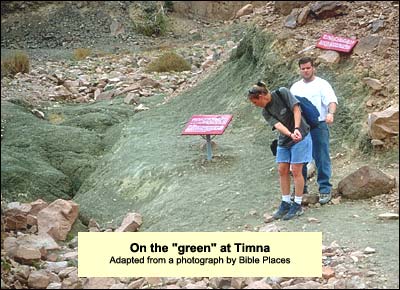
This whole development started with copper. Timna is full of copper ore, as is biblical Punon (modern Feinan), 90 miles to the north on Jordan's side of the Arava. In many places the ore appears as green patches, sometimes giving the illusion of grass. The copper was originally in the crystalline stone of the area, such as the granite of Mt. Timna: long ago, flowing water separated the copper ore from the rock and deposited it in shallow bays. The main forms are chalcocite and blue-green malachite. Today called Eilat stone, the latter was also a favorite jewelry stone in antiquity.
The average copper content of the ore does not top 3%, but the known reserves amount to 22 million tons, and there have been times when mining was worthwhile. The modern Israelis mined copper here, mainly for copper cement, although the works are no longer in use.
Evidence of Chalcolithic mining was found about a mile east of Mt. Timna's southern tip. The copper-stone people would have had to attain a heat, in their ovens, of 1200 degrees centigrade (2192 F.). They would have used goatskin bellows to maintain this heat for five to seven hours, until the copper separated out and dropped to the bottom. They probably used acacia wood for fuel, for these trees are plentiful in the wadis: their intricate root systems reach deep into the stream bed, finding water left by flash floods. Acacias burn to a high heat; even today they are the basis of a charcoal industry in Sinai.
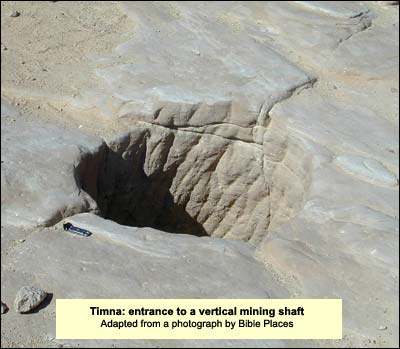
Within Timna Park we shall visit the Egyptian and Midianite mines, which functioned from the 14th through the 12th centuries BC. To reach them, we drive from Solomon's Pillars a little distance back toward the entrance, finding a road that branches NW. We stay on this, passing the Mushroom camp (to which we shall return). A branch to the right leads to a place of rock drawings made by the Egyptians and Midianites. These include scenes of ibex-hunting, as well as scenes of ox-drawn carts guarded by armed soldiers, probably the Egyptians.
If we left the main road in order to see the drawings, we now return to it and follow it to its end, a parking lot. Here the white sandstone forms natural arches. The fit and adventurous may wish to take the blue-marked trail to the right; it will lead down a series of small dry water chutes and then to a modest canyon. Otherwise we follow it to the left. On the way, we see the opening of a vertical shaft. About a thousand such shafts have been discovered, although most today are filled with sand, giving the effect of round plates. They served for air, as well as entrance and exit.
In the canyon we can see the horizontal shafts in which the miners worked. We can gather in the anteroom of one and hear Job 28:
“Surely there is a mine for silver, and a place for gold which they refine. Iron is taken out of the earth, and copper is smelted out of the ore. Man sets an end to darkness, and searches out, to the furthest bound, the stones of obscurity and of thick darkness. He breaks open a shaft away from where people live. They are forgotten by the foot. They hang far from men, they swing back and forth. As for the earth, out of it comes bread; Underneath it is turned up as it were by fire. Sapphires come from its rocks. It has dust of gold. That path no bird of prey knows, neither has the falcon’s eye seen it. The proud animals have not trodden it, nor has the fierce lion passed by there. He puts forth his hand on the flinty rock, and he overturns the mountains by the roots. He cuts out channels among the rocks. His eye sees every precious thing. He binds the streams that they don’t trickle. The thing that is hidden he brings forth to light.“ But where shall wisdom be found? Where is the place of understanding? More...
Using the marked trail, if we mount the ridge on the NW side of this little canyon, we can get a view of many "plates" that mark the openings of vertical shafts.
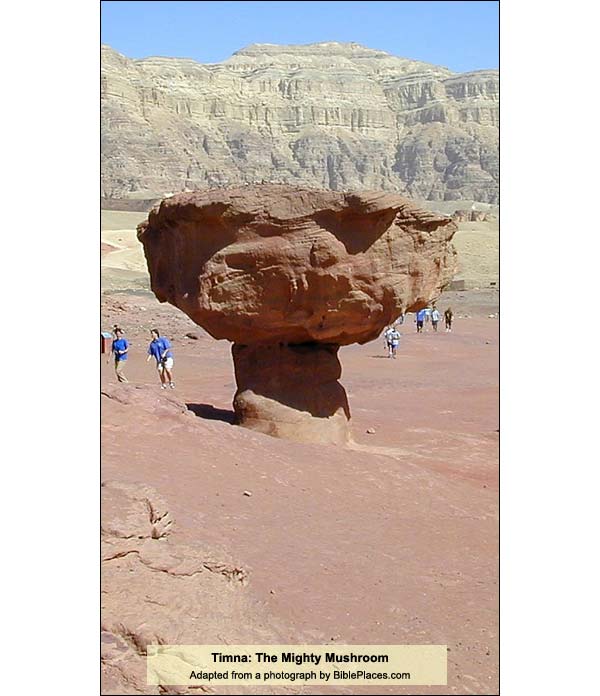
We return to the bus and drive back on the road that brought us here. After a mile or so there is a place to pull over on the right. Here we see a piece of sandstone eroded into the shape of a mushroom. Around it are the remains of a large Egyptian-Midianite smelting camp, including the replica of an oven. The original is in the Haaretz Museum (after reaching its page, go to Permanent Exhibitions and choose "5" for the Nechushtan Pavilion).
There is also a contemporary picture of the Egyptian smelting process (enlarge the image on the upper left of this external link), among other crafts, in the tomb of Rechmire, vizier to Pharaoh Thutmosis III. In the upper register, on the left, two workers are gingerly removing a hot copper ingot from the oven. To their right we see an earlier stage of the process: one worker operates the bellows while another pokes into the oven to keep the temperature up. The one on the bellows works with hands and feet: he raises one foot with a rope so that the bellows will fill with air, at the same time stamping on a second bellows so that it will emit its air into the oven - this alternately. In the lower register, the same two scenes are repeated in reverse order. After the copper separated from its ore and dropped to the bottom of the oven, a worker opened a hole in the side of the oven and the slag poured through a channel into a pit.
{mospagebreak title=Timna Logistics}
Timna Logistics
Timna Park is not included within the National Parks and Nature Reserves. One should phone ahead for opening hours and entrance fees: 08-6316756. As of February 2004, entry is permitted until 16:00, and the exit gate remains open until 19:30.
The park also contains a small lake with a restaurant.